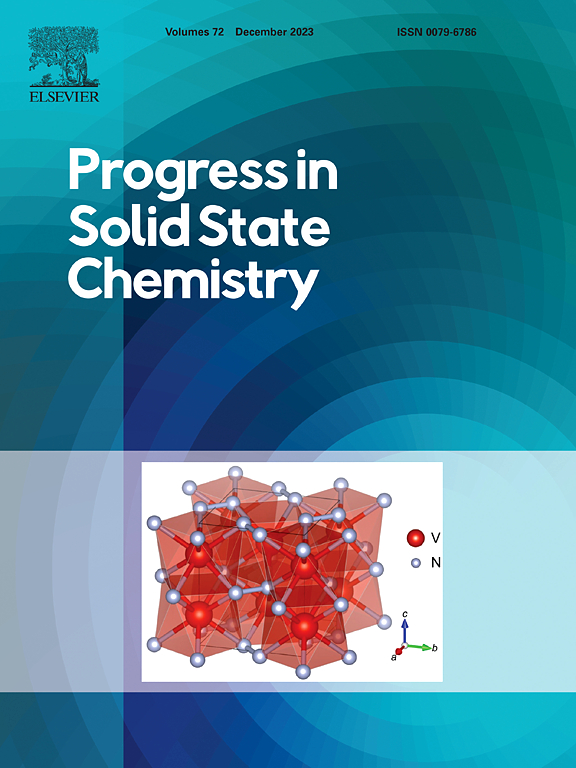Study on novel blue-purple high-NIR reflectance pigments and acrylic coatings based on Ca2Zn1-xMxSi2O7 (M = Mn and Ni)
IF 10.5
2区 化学
Q1 CHEMISTRY, INORGANIC & NUCLEAR
引用次数: 0
Abstract
The coating optimized with high near-infrared reflectance pigments can effectively reduce the energy consumption for heating and cooling in buildings, thereby alleviating the pressure on global energy consumption. Using a high-temperature solid-state method, blue-violet pigments with high near-infrared reflectance, Ca2Zn1-xMxSi2O7 (M = Mn, 0 ≤ x ≤ 0.4 and Ni, 0 ≤ x ≤ 0.2) solid solutions, were synthesized for the first time, with a maximum solar reflectance of 82.67%. Using XPS analysis, it was determined that the oxidation state of Ni in the pigment is +2, while Mn exists in mixed oxidation states of +2 and +3. UV-VIS-NIR spectroscopy analysis indicates that the blue-violet color of the pigment originates from the d-d transitions of the transition metal ions. As the doping concentration increases, the near-infrared reflectance of the pigment decreases. The DFT calculations have also confirmed that the color of pigments originates from transition metal ions. The as-synthesized pigments were incorporated into acrylic to create colored coatings. Improving the near-infrared solar reflectance of the acrylic coating. The excellent high near-infrared solar reflectance and coating property optimization make the synthesized pigment a potential energy-saving coating.

基于Ca2Zn1-xMxSi2O7 (M = Mn和Ni)的新型蓝紫色高近红外反射颜料及丙烯酸涂料的研究
采用高近红外反射率颜料优化的涂料,可以有效降低建筑的供暖和制冷能耗,从而缓解全球能源消耗压力。采用高温固相法首次合成了具有高近红外反射率的蓝紫色颜料Ca2Zn1-xMxSi2O7 (M = Mn, 0≤x≤0.4,Ni, 0≤x≤0.2)固溶体,最大太阳反射率为82.67%。通过XPS分析,确定了Ni在颜料中的氧化态为+2,Mn以+2 +3的混合氧化态存在。紫外-可见-近红外光谱分析表明,颜料的蓝紫色源于过渡金属离子的d-d跃迁。随着掺杂浓度的增加,颜料的近红外反射率降低。DFT计算也证实了颜料的颜色来源于过渡金属离子。合成的颜料被掺入丙烯酸制成彩色涂料。提高丙烯酸涂料的近红外太阳反射率。优异的高近红外太阳反射率和涂层性能优化使合成的颜料成为一种有潜力的节能涂料。
本文章由计算机程序翻译,如有差异,请以英文原文为准。
求助全文
约1分钟内获得全文
求助全文
来源期刊

Progress in Solid State Chemistry
化学-无机化学与核化学
CiteScore
14.10
自引率
3.30%
发文量
12
期刊介绍:
Progress in Solid State Chemistry offers critical reviews and specialized articles written by leading experts in the field, providing a comprehensive view of solid-state chemistry. It addresses the challenge of dispersed literature by offering up-to-date assessments of research progress and recent developments. Emphasis is placed on the relationship between physical properties and structural chemistry, particularly imperfections like vacancies and dislocations. The reviews published in Progress in Solid State Chemistry emphasize critical evaluation of the field, along with indications of current problems and future directions. Papers are not intended to be bibliographic in nature but rather to inform a broad range of readers in an inherently multidisciplinary field by providing expert treatises oriented both towards specialists in different areas of the solid state and towards nonspecialists. The authorship is international, and the subject matter will be of interest to chemists, materials scientists, physicists, metallurgists, crystallographers, ceramists, and engineers interested in the solid state.
 求助内容:
求助内容: 应助结果提醒方式:
应助结果提醒方式:


